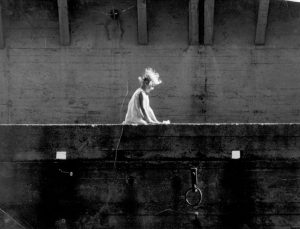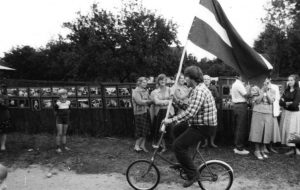The filming of documentary materials in Latvia began even before the establishment of the Latvian state. The earliest of these materials to have survived to the present day were filmed in 1910 (footage of the Russian tsar’s visit to Riga), and there is documentary evidence that the new medium of cinema reached Riga as well as the capitals of other developed European countries soon after the first public screenings by the Lumière brothers in 1895.
Cinema began to attract more attention in the 1920s and 30s, when a significant part of all film production in Latvia consisted of newsreels and short films.
The production of such formats was promoted by a deliberate, and relatively unique, state policy dictating that film screenings include newsreels filmed in Latvia. Documentary footage of various events was filmed by small local companies (Latvju Filma, the Arnolds Cālītis Film-Photo Commerce House, etc.) and representative offices of foreign companies (Pathe, UFA, etc.).
The first feature-length documentary films in Latvia were released in the early 1930s.
In terms of genre, these films could be classified as “cultural films”. For example, Daugava (1934, director Aleksandrs Rusteiķis), which was the first feature-length sound film in Latvia with a distinct cultural and historical theme, consisted of a staged plot in a documentary environment, namely, a raft journey on the Daugava River from the Latvian border to the mouth of the river near Riga, filming life and nature along the river banks. Unfortunately, the film has not survived to the present day.
As the Latvian Soviet Socialist Republic was established in 1940, the first films to be made under the new regime were newsreels, because they provided an easy and quick means of ideological propaganda. Several propaganda-themed documentaries were created during the wartime German occupation as well. After the Second World War, newsreels (or film journals, as they were called during the Soviet era) became an essential part of the film industry; beginning in 1946, a ten-minute film journal was released every week. The main such film journal was Padomju Latvija / Soviet Latvia, which reported the most important events in the country. From the late 1950s onward, the film journals Pionieris / Young Pioneer (for children and youths), Māksla / Art (beginning in 1963), Sports / Sports Review and later also Gaismēnas / Chiaroscuro were produced on approximately a quarterly basis.
The documentary films of the 1940s and 50s did not have a particularly artistic character, but the situation at the Riga Film Studio changed in 1960.
This resonated with events elsewhere in the world, where young filmmakers entering the scene had a new, more unusual perspective on the realities of the time
and wished to experiment with stylistic techniques and technological innovations (widescreen cameras, later also synchronised sound recording). In Latvia, the new generation of documentary filmmakers began making films characterised by a more personal tone, a specially developed visual quality and unexpected combinations of metaphors, text and images. Just as important an innovation was immersing themselves in the filmed environment and protagonists as well as exploring their characters and revealing them on screen. This aesthetic phenomenon – represented by director and cinematographer Uldis Brauns, screenwriter and director Aivars Freimanis, screenwriter Armīns Lejiņš, cinematographer and director Ivars Seleckis, screenwriter and director Herz Frank and others – became known as the Riga style, or the Riga School of Poetic Documentary Cinema.

The presence of this poetic style was also felt in the subsequent decades, but films with social themes, in which the filmmakers focused on specific topical issues, became the dominant trend in the 1970s and 80s. The films by Seleckis concentrated on the role of women and the family in society as well as on life in rural Latvia; Frank examined not only socio-economic but also ethical issues, including moral choice and responsibility. Laima Žurgina specialised in expressive portraits of people; Ansis Epners also worked in an expressive manner. Cinematographer Juris Podnieks made his directorial debut, and his films in the 1980s, especially Vai viegli būt jaunam? / Is It Easy to Be Young? (1986), resonated widely beyond Latvia and revealed this filmmaker’s ability to sensitively capture his era.
Seleckis’ film Šķērsiela / Crossroad Street (1988; award for best European documentary film in 1990) – which observed the everyday life of the inhabitants of a small street in Riga through their relationships, destinies and life stories, thus reflecting the complex twists and turns of Latvian history – gained wide international acclaim.

Whereas Latvia had previously had a single centre for film production, after the country regained its independence, several independent film studios were formed in which the producer became an important part of the filmmaking process. Newsreels continued to be made until the mid-1990s but were then discontinued due to financial reasons as well as the ever more widespread use of faster news sources and media.
Many new film studios were established and new filmmakers appeared on the scene during this decade. Laila Pakalniņa began making films in a distinctly different style characterised by long, contemplative, precisely composed scenes (her short films Veļa / The Linen (1991), Prāmis / The Ferry (1994) and Pasts / The Mail (1995) were screened at the Cannes Film Festival and received the FIPRESCI Award). Today, too, documentary films by Latvian directors are regularly selected for leading international film festivals, confirming the specific yet universal perspective of the country’s documentary filmmakers.
Zane Balčus, Film Historian,
Baltic Sea Docs Project Manager